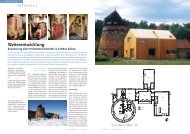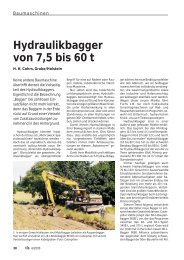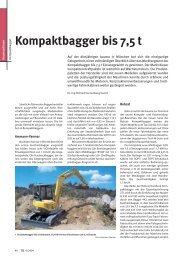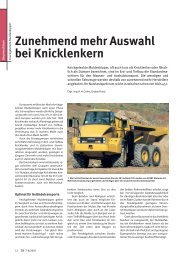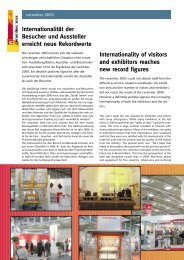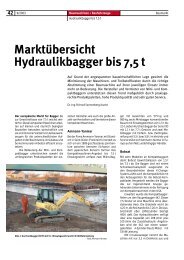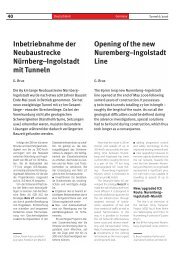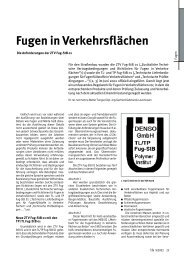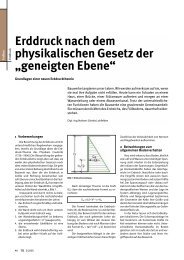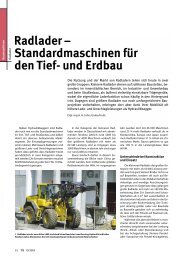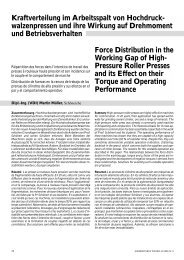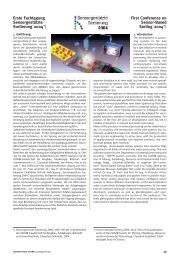Geschichte der Spritzbetonbauweise, Teil IV - Bauverlag
Geschichte der Spritzbetonbauweise, Teil IV - Bauverlag
Geschichte der Spritzbetonbauweise, Teil IV - Bauverlag
Sie wollen auch ein ePaper? Erhöhen Sie die Reichweite Ihrer Titel.
YUMPU macht aus Druck-PDFs automatisch weboptimierte ePaper, die Google liebt.
<strong>Geschichte</strong> <strong>der</strong> <strong>Spritzbetonbauweise</strong>, <strong>Teil</strong> <strong>IV</strong><br />
History of the Sprayed Concrete Lining Method, P. <strong>IV</strong><br />
sung, die NÖT stelle eine<br />
„Beobachtungsmethode“ dar,<br />
beruht zum <strong>Teil</strong> auf diesem<br />
Fehlkonzept. 1952 verzichtete<br />
Rabcewicz auf sein Patent,<br />
das er nie in die Praxis umsetzen<br />
konnte (Spang 1996)<br />
und in dem we<strong>der</strong> Spritzbeton<br />
noch Anker o<strong>der</strong> Stahlbogen<br />
überhaupt Erwähnung<br />
fanden. Trotz alledem<br />
betrachtete er sich selbst als<br />
Erfin<strong>der</strong> <strong>der</strong> „Spritzbeton-Ankerungs-Bauweise“<br />
und ließ<br />
sich als ihr Vater feiern. Auch<br />
NÖT-Historiker berichteten<br />
kürzlich wie folgt: „Vom Exil<br />
in Südamerika aus reichte er<br />
1948 die NÖT in Wien zum<br />
Patent ein“ (Mayr 1994).<br />
Nach dem Verlust seiner Professur<br />
an <strong>der</strong> Technischen<br />
Universität Wien verfasste er<br />
eine Dissertation (Rabcewicz<br />
1950), in <strong>der</strong> er preis<br />
gab, bis Dezember 1950 we<strong>der</strong><br />
von Spritzbeton noch<br />
von Ankern Kenntnis gehabt<br />
zu haben. Im Gegenteil, Rabcewicz<br />
befasste sich dort<br />
noch immer mit einer Ausbruchsicherung<br />
aus Schalungsbeton<br />
mit Mindestdicken<br />
von 30 cm. Selbst die<br />
Bedeutung des damals schon<br />
weit verbreiteten Stahleinbaus<br />
entging ihm zu dieser<br />
Zeit vollkommen. Der Felsankerung<br />
begegnete er erst<br />
Anfang <strong>der</strong> 50er-Jahre im<br />
Laufe von Arbeiten mit <strong>der</strong><br />
schwedischen Unternehmung<br />
Svenska Enterprenad<br />
AB Sentab. Felsanker und<br />
Gunit setzte er in Nachahmung<br />
des Delaware Projektes<br />
in New York (siehe <strong>Teil</strong> III)<br />
erstmals beim Bau einer Kavernenzentrale<br />
in Brasilien<br />
ein. Er berichtet darüber folgen<strong>der</strong>maßen:<br />
„Ein Abschnitt<br />
<strong>der</strong> Kavernenfirste<br />
wurde auch geankert, aber<br />
lei<strong>der</strong> nur vier Wochen nach<br />
dem Ausbruch. (...) Die Anker<br />
waren, um wirksam zu sein,<br />
zu spät und zu inkorrekt angewandt“<br />
(Rabcewicz 1955).<br />
Die erste Veröffentlichung<br />
von Rabcewicz über Felsanker<br />
erschien in <strong>der</strong> Tat erst<br />
1953. Es folgten zwei Weitere,<br />
in denen er nur zusammenfasste,<br />
was er in dem damals<br />
schon umfangreichen Schrifttum<br />
vorgefunden hatte. Im<br />
Jahre 1957 beschrieb er Laborversuche<br />
mit Ankern in<br />
kohäsionslosem Sand ohne<br />
reproduzierbare Ergebnisse.<br />
Seine erste Arbeit über die<br />
Anwendung von Spritzbeton<br />
und Ankern in größerem<br />
Umfang erschien erst vier<br />
Jahre später. Wie oben erwähnt,<br />
schritt Rabcewicz in<br />
<strong>der</strong> Folge zur Umbenennung<br />
<strong>der</strong> <strong>Spritzbetonbauweise</strong> in<br />
„Neue Österreichische Tunnelbauweise“.<br />
Dies ist umso<br />
befremden<strong>der</strong>, als er zu jenem<br />
Zeitpunkt über die Vorgeschichte<br />
<strong>der</strong> Spritzbetonund<br />
Anker-Technologie bereits<br />
vollumfänglich im Bild<br />
war (Rabcewicz 1954, 1955<br />
und 1961). Von den Möglichkeiten<br />
des Stahleinbaus erfuhr<br />
er allerdings erst zwei<br />
Jahre später: „Bei einem sehr<br />
interessanten Vorschlag, <strong>der</strong><br />
dem Verfasser kürzlich zur<br />
Kenntnis kam, wird die Sofortsicherung<br />
sehr wirtschaftlich<br />
und wirksam durch<br />
Stahlträger erreicht“ (Rabcewicz<br />
und Sattler 1965).<br />
Wir haben das Schrifttum<br />
über die Entwicklung und<br />
Anwendung des Spritzbetons<br />
und <strong>der</strong> Anker seit<br />
ihren Anfängen – so weit auffindbar<br />
– gesammelt. Die<br />
Anzahl <strong>der</strong> publizierten Seiten<br />
pro Kalen<strong>der</strong>jahr ist in<br />
Bild 6 dargestellt. Man erkennt<br />
eine gewisse Kontinuität<br />
<strong>der</strong> Veröffentlichungen<br />
über den Spritzbeton,<br />
die offenkundig nur durch<br />
den zweiten Weltkrieg unterbrochen<br />
wurde. Im Falle <strong>der</strong><br />
Felsanker geriet die Erfindung<br />
(1913), mit wenigen<br />
Ausnahmen, bis in die 40er-<br />
Jahre in Vergessenheit, als<br />
bolts during his involvement<br />
with the Swedish company<br />
Svenska Enterprand AB<br />
Sentab in the early 1950s.<br />
Adopting ideas from the<br />
Delaware Project in New York<br />
(see Part III), he applied rock<br />
bolts and gunite in the rock<br />
chamber of a hydroelectric<br />
scheme. He reported on the<br />
work in the following way: “A<br />
part of the roof of the un<strong>der</strong>ground<br />
chamber was rockbolted,<br />
but unfortunately only<br />
4 weeks after excavation. (…)<br />
The rock bolts were installed<br />
too late and incorrectly thus<br />
they did not have any<br />
effect” (Rabcewicz 1955).<br />
Rabcewicz’s first paper on<br />
rock bolting did not appear<br />
until 1953, followed by two<br />
other publications in which he<br />
only summarised what he had<br />
found in literature, which even<br />
then was extensive. In 1957,<br />
Rabcewicz reports on laboratory<br />
tests with rock bolting in<br />
sand with no reproducible results.<br />
His first paper in any<br />
depth on the use of shotcrete<br />
and rock bolting did not appear<br />
until 4 years later. As<br />
mentioned above, in 1963,<br />
Rabcewicz subsequently renamed<br />
the “shotcreting<br />
method“ the “New Austrian<br />
Tunnelling Method“. This is all<br />
the more surprising, as at that<br />
time he was well informed<br />
about the background of the<br />
shotcrete and rock bolting<br />
technology (Rabcewicz 1954,<br />
1955 and 1961). He realised<br />
the importance of using steel<br />
sets only two years later:<br />
“With regard to a very interesting<br />
proposal, which recently<br />
came to the attention of the<br />
author, the immediate temporary<br />
support can be achieved<br />
very economically and effectively<br />
using steel ribs” (Rabcewicz<br />
and Sattler 1965).<br />
We have collected the<br />
available papers from all over<br />
the world on the development<br />
and application of shotcrete<br />
and rock bolts and – in so far<br />
as we could find them – from<br />
their very beginnings. The<br />
number of pages published<br />
per year is depicted in Fig. 6.<br />
One can recognise continuity<br />
in the publications on shotcrete,<br />
obviously interrupted<br />
by the Second World War. In<br />
the case of rock bolts, however,<br />
their invention (1913),<br />
with a few exceptions, went<br />
largely unnoticed until the<br />
1940s, when suddenly there<br />
was lively interest in their application<br />
and further development.<br />
When the term NATM<br />
was introduced in 1963, very<br />
few of the publications stem<br />
from the protagonists of the<br />
NATM, and these date only as<br />
from 1953. There was nothing<br />
new in them either technologically<br />
or theoretically.<br />
Rabcewicz’s claim that he<br />
originated the “Shotcrete –<br />
Rock Bolt Construction<br />
Method” or (with reference to<br />
Brunner) that “it was developed<br />
and tried out in Austria“<br />
has no foundation at all.<br />
The same Brunner applied<br />
in 1955 for a patent (“A<br />
method for the construction<br />
of adits, tunnels and shafts in<br />
squeezing rock”) both in Austria<br />
and Germany. The patent<br />
was issued in 1956 with the<br />
following claims: “Dispensing<br />
with timber and steel supports,<br />
immediately after blasting<br />
the profile is lined with a<br />
rapid-hardening layer of shotcrete.<br />
(…) First of all, in the<br />
lower part of the profile, a tunnel<br />
of small cross section is<br />
excavated followed by the remain<strong>der</strong><br />
of the profile. (…)<br />
When applying the shotcrete<br />
layer some steel reinforcement,<br />
for example a piece of<br />
wire mesh, is embedded in<br />
the shotcrete“. Beside this, he<br />
also proposed an old-fashioned<br />
multiple adit method of<br />
construction with a total of 8<br />
partial headings (Fig. 7) and<br />
believed that one could do<br />
Tunnel 5/2002 17



